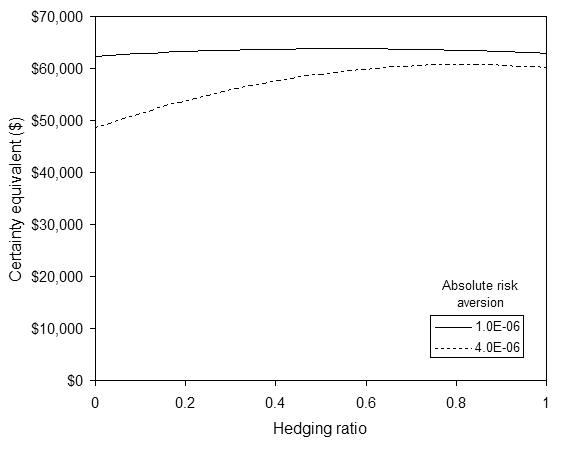107 – Why don’t farmers use futures markets more?
Most of us prefer to avoid risk if we can. Some farmers reduce their risk by “hedging” – that is by locking in the sale price of their production in advance using futures contracts or fixed-price contracts. However, only a minority of farmers do so. Why is that?
The simplest economic models of price hedging indicate that producers should always hedge all of their production. This will eliminate their risk of the sale price falling by the time they have produce ready to sell. Of course it will also eliminate the chance of the price rising, but for most people, falls matter more than rises (i.e. most people are “risk averse”).
From that description, hedging seems like a great opportunity to reduce one of farmers’ main risks. Why then, is hedging not a dominant practice in agriculture. There are several reasons.
One is that the simplest models are too simple. They neglect several factors that tend to reduce the attractiveness of futures contracts.
- Transaction costs. Participating in the futures markets takes time and costs money. For example, in futures markets, producers have to meet margin calls, which require them to pay money in advance for a proportion of the value of the contract. This is inconvenient, and it has interest costs. It has been estimated that the transaction costs amount to about 2% of the value of futures contracts in Australia.
- Basis risk. When a farmer signs up for a futures contract, it is usually not for exactly the same product as the farmer is producing. The future market price of the product specified in the futures contract will probably vary in a (hopefully slightly) different way to the product the farmer is producing, so the contract doesn’t exactly cancel out the price risk that the farmer faces.
- Production risks. If you allow for the fact that the amount of product that will be available for sale at the end of the growing season is not known with certainty, it can be preferable to hedge only a portion of the expected production (depending on other circumstances).
Another reason is that hedging does not only affect the riskiness of the farmer’s outcome – it also affects the expected level of payoff (“expected” in the statistical sense of a weighted average). Most economic research publications on hedging make the assumption that the farmer’s expectations about price match the market’s; their expected price is the same as the futures price. In reality, a population of apparently similar farmers has a wide variety of price expectations. For those who are relatively optimistic about prices, there is a disadvantage in locking in at what they perceive to be a low price. Doing so would reduce their expected income, so they choose not to hedge.
Then there is the question of how much a farmer has to gain from hedging. If the farmer is among the majority of farmers who are not very risk averse, there may be little benefit in hedging. Figure 1 shows one example. The horizontal axis shows the proportion of expected wool production that the farmer might hedge, and the vertical axis shows the payoff from doing so. The payoff is called the certainty equivalent, which consists of the expected profit minus a risk premium. For a wool farmer with low risk aversion, and with price expectations that match the futures market, the potential gain in certainty equivalent by moving from zero hedging (the left edge of the top curve) to the optimal level (56%) is tiny. In other words, the payoff function is very flat (another example to add to those discussed by Pannell (2006)).
Figure 1.
There is a more substantial gain from hedging possible for highly risk-averse farmers (the dashed curve), but we know from empirical studies that they are a minority. Given this result alone, it is not surprising that the majority of farmers have a limited interest in futures markets.
David Pannell, The University of Western Australia
Further Reading
Pannell, D.J., Hailu, G. Weersink, A., and Burt, A. (2007). More reasons why farmers have so little interest in futures markets, submitted to Agricultural Economics, pre-publication version available here (132K pdf file).
Pannell, D.J. (2006). Flat-earth economics: The far-reaching consequences of flat payoff functions in economic decision making, Review of Agricultural Economics 28(4): 553-566. Prepublication version here (44K).
